3.5. Configuring a VPLS Service with CLI
This section provides information to configure a VPLS service using the command line interface.
3.5.1. Basic Configuration
The following fields require specific input (there are no defaults) to configure a basic VPLS service:
- Customer ID (refer to the 7450 ESS, 7750 SR, 7950 XRS, and VSR Services Overview Guide for more information)
- For a local service, configure two SAPs, specifying local access ports and encapsulation values.
- For a distributed service, configure a SAP and an SDP for each far-end node.
The following example shows a sample configuration of a local VPLS service on ALA-1.
The following example shows a sample configuration of a distributed VPLS service between ALA-1, ALA-2, and ALA-3.
3.5.2. Common Configuration Tasks
This section provides a brief overview of the tasks that must be performed to configure both local and distributed VPLS services and provides the CLI commands.
For VPLS services:
- Associate VPLS service with a customer ID
- Define SAPs:
- Select node(s) and port(s)
- Optional — Select QoS policies other than the default (configured in config>qos context)
- Optional — Select filter policies (configured in config>filter context)
- Optional — Select accounting policy (configured in config>log context)
- Associate SDPs for (distributed services)
- Modify STP default parameters (optional) (see VPLS and Spanning Tree Protocol)
- Enable service
3.5.3. Configuring VPLS Components
Use the CLI syntax displayed in the following sections to configure VPLS components.
3.5.3.1. Creating a VPLS Service
Use the following CLI syntax to create a VPLS service.
The following example shows a VPLS configuration:
3.5.3.2. Enabling Multiple MAC Registration Protocol (MMRP)
Once MMRP is enabled in the B-VPLS, it advertises the presence of the I-VPLS instances associated with this B-VPLS.
The following example shows a configuration with MMRP enabled.
Since I-VPLS 11 is associated with B-VPLS 100, MMRP advertises the group B-MAC 01:1e:83:00:00:0b) associated with I-VPLS 11 through a declaration on all the B-SAPs and B-SDPs. If the remote node also declares an I-VPLS 11 associated with its B-VPLS 10, then this results in a registration for the group B-MAC. This also creates the MMRP multicast tree (MFIB entries). In this case, sdp 3201:100 is connected to a remote node that declares the group B-MAC.
The following show commands display the current MMRP information for this scenario:
3.5.3.2.1. Enabling MAC Move
The mac-move feature is useful to protect against undetected loops in your VPLS topology as well as the presence of duplicate MACs in a VPLS service. For example, if two clients in the VPLS have the same MAC address, the VPLS will experience a high re-learn rate for the MAC and will shut down the SAP or spoke-SDP when the threshold is exceeded.
Use the following CLI syntax to configure mac-move parameters.
The following example shows a mac-move configuration:
3.5.3.2.2. Configuring STP Bridge Parameters in a VPLS
Modifying some of the Spanning Tree Protocol parameters allows the operator to balance STP between resiliency and speed of convergence extremes. Modifying particular parameters, as follows, must be done in the constraints of the following two formulas:
2 x (Bridge_Forward_Delay - 1.0 seconds) ≥ Bridge_Max_Age Bridge_Max_Age ≥ 2 x (Bridge_Hello0_Time + 1.0 seconds)
The following STP parameters can be modified at VPLS level:
STP always uses the locally configured values for the first three parameters (Admin State, Mode, and Priority).
For the parameters Max Age, Forward Delay, Hello Time, and Hold Count, the locally configured values are only used when this bridge has been elected root bridge in the STP domain; otherwise, the values received from the root bridge are used. The exception to this rule is: when STP is running in RSTP mode, the Hello Time is always taken from the locally configured parameter. The other parameters are only used when running mode MSTP.
3.5.3.2.2.1. Bridge STP Admin State
The administrative state of STP at the VPLS level is controlled by the shutdown command.
When STP on the VPLS is administratively disabled, any BPDUs are forwarded transparently through the 7450 ESS, 7750 SR, or 7950 XRS. When STP on the VPLS is administratively enabled, but the administrative state of a SAP or spoke-SDP is down, BPDUs received on such a SAP or spoke-SDP are discarded.
3.5.3.2.2.2. Mode
To be compatible with the different iterations of the IEEE 802.1D standard, the 7450 ESS, 7750 SR, and 7950 XRS support several variants of the Spanning Tree protocol:
- rstp — Rapid Spanning Tree Protocol (RSTP) compliant with IEEE 802.1D-2004 - default mode.
- dot1w — Compliant with IEEE 802.1w.
- comp-dot1w — Operation as in RSTP but backwards compatible with IEEE 802.1w (this mode was introduced for interoperability with some MTU types).
- mstp — Compliant with the Multiple Spanning Tree Protocol specified in IEEE 802.1Q REV/D5.0-09/2005. This mode of operation is only supported in an M-VPLS.
- pmstp — Compliant with the Multiple Spanning Tree Protocol specified in IEEE 802.1Q REV/D3.0-04/2005 but with some changes to make it backwards compatible to 802.1Q 2003 edition and IEEE 802.1w.
See section Spanning Tree Operating Modes for more information about these modes.
Default: rstp
3.5.3.2.2.3. Bridge Priority
The bridge-priority command is used to populate the priority portion of the bridge ID field within outbound BPDUs (the most significant 4 bits of the bridge ID). It is also used as part of the decision process when determining the best BPDU between messages received and sent. When running MSTP, this is the bridge priority used for the CIST.
All values will be truncated to multiples of 4096, conforming with IEEE 802.1t and 802.1D-2004.
Range: 1 to 65535
Default: 32768
Restore Default: no priority
3.5.3.2.2.4. Max Age
The max-age command indicates how many hops a BPDU can traverse the network starting from the root bridge. The message age field in a BPDU transmitted by the root bridge is initialized to 0. Each other bridge will take the message_age value from BPDUs received on their root port and increment this value by 1. Therefore, the message_age reflects the distance from the root bridge. BPDUs with a message age exceeding max-age are ignored.
STP uses the max-age value configured in the root bridge. This value is propagated to the other bridges by the BPDUs. The default value of max-age is 20. This parameter can be modified within a range of 6 to 40, limited by the standard STP parameter interaction formulas.
Range: 6 to 40 seconds
Default: 20 seconds
Restore Default: no max-age
3.5.3.2.2.5. Forward Delay
RSTP, as defined in the IEEE 802.1D-2004 standards, will normally transition to the forwarding state by a handshaking mechanism (rapid transition), without any waiting times. If handshaking fails (for example, on shared links, as follows), the system falls back to the timer-based mechanism defined in the original STP (802.1D-1998) standard.
A shared link is a link with more than two Ethernet bridges (for example, a shared 10/100BaseT segment). The port-type command is used to configure a link as point-to-point or shared (see section SAP Link Type).
For timer-based transitions, the 802.1D-2004 standard defines an internal variable forward-delay, which is used in calculating the default number of seconds that a SAP or spoke-SDP spends in the discarding and learning states when transitioning to the forwarding state. The value of the forward-delay variable depends on the STP operating mode of the VPLS instance:
- In RSTP mode, but only when the SAP or spoke-SDP has not fallen back to legacy STP operation, the value configured by the hello-time command is used.
- In all other situations, the value configured by the forward-delay command is used.
Range: 4 to 30 seconds
Default: 15 seconds
Restore Default: no forward-delay
3.5.3.2.2.6. Hello Time
The hello-time command configures the Spanning Tree Protocol (STP) hello time for the Virtual Private LAN Service (VPLS) STP instance.
The seconds parameter defines the default timer value that controls the sending interval between BPDU configuration messages by this bridge, on ports where this bridge assumes the designated role.
The active hello time for the spanning tree is determined by the root bridge (except when the STP is running in RSTP mode, then the hello time is always taken from the locally configured parameter).
The configured hello-time value can also be used to calculate the bridge forward delay; see Forward Delay.
Range: 1 to 10 seconds
Default: 2 seconds
Restore Default: no hello-time
3.5.3.2.2.7. Hold Count
The hold-count command configures the peak number of BPDUs that can be transmitted in a period of one second.
Range: 1 to 10
Default: 6
Restore Default: no hold-count
3.5.3.2.2.8. MST Instances
You can create up to 15 mst-instances. They can range from 1 to 4094. By changing path-cost and priorities, you can ensure that each instance will form its own tree within the region, therefore ensure that different VLANs follow different paths.
You can assign non-overlapping VLAN ranges to each instance. VLANs that are not assigned to an instance are implicitly assumed to be in instance 0, which is also called the CIST. This CIST cannot be deleted or created.
The parameters that can be defined per instance are mst-priority and vlan-range.
- mst-priority — The bridge-priority for this specific mst-instance. It follows the same rules as bridge-priority. For the CIST, the bridge-priority is used.
- vlan-range — The VLANs are mapped to this specific mst-instance. If no VLAN-ranges are defined in any mst-instances, then all VLANs are mapped to the CIST.
3.5.3.2.2.9. MST Max Hops
The mst-max-hops command defines the maximum number of hops the BPDU can traverse inside the region. Outside the region, max-age is used.
3.5.3.2.2.10. MST Name
The MST name defines the name that the operator gives to a region. Together with MST revision and the VLAN to mst-instance mapping, it forms the MST configuration identifier. Two bridges that have the same MST configuration identifier form a region if they exchange BPDUs.
3.5.3.2.2.11. MST Revision
The MST revision together with MST-name and VLAN to MST-instance mapping define the MST configuration identifier. Two bridges that have the same MST configuration identifier form a region if they exchange BPDUs.
3.5.3.3. Configuring GSMP Parameters
The following parameters must be configured in order for GSMP to function:
- One or more GSMP sessions
- One or more ANCP policies
- For basic subscriber management only, ANCP static maps
- For enhanced subscriber management only, associate subscriber profiles with ANCP policies
Use the following CLI syntax to configure GSMP parameters.
This example shows a GSMP group configuration.
3.5.3.4. Configuring a VPLS SAP
A default QoS policy is applied to each ingress and egress SAP. Additional QoS policies can be configured in the config>qos context. There are no default filter policies. Filter policies are configured in the config>filter context and must be explicitly applied to a SAP. Use the following CLI syntax to create:
3.5.3.4.1. Local VPLS SAPs
To configure a local VPLS service, enter the sap sap-id command twice with different port IDs in the same service configuration.
The following example shows a local VPLS configuration:
3.5.3.4.2. Distributed VPLS SAPs
To configure a distributed VPLS service, you must configure service entities on originating and far-end nodes. You must use the same service ID on all ends (for example, create a VPLS service ID 9000 on ALA-1, ALA-2, and ALA-3). A distributed VPLS consists of a SAP on each participating node and an SDP bound to each participating node.
For SDP configuration information, refer to the 7450 ESS, 7750 SR, 7950 XRS, and VSR Services Overview Guide. For SDP binding information, see Configuring SDP Bindings.
The following example shows a configuration of VPLS SAPs configured for ALA-1, ALA-2, and ALA-3.
3.5.3.4.3. Configuring SAP-Specific STP Parameters
When a VPLS has STP enabled, each SAP within the VPLS has STP enabled by default. The operation of STP on each SAP is governed by:
3.5.3.4.3.1. SAP STP Administrative State
The administrative state of STP within a SAP controls how BPDUs are transmitted and handled when received. The allowable states are:
- SAP Admin UpThe default administrative state is up for STP on a SAP. BPDUs are handled in the normal STP manner on a SAP that is administratively up.
- SAP Admin DownAn administratively down state allows a service provider to prevent a SAP from becoming operationally blocked. BPDUs will not originate out the SAP toward the customer.If STP is enabled on VPLS level, but disabled on the SAP, received BPDUs are discarded. Discarding the incoming BPDUs allows STP to continue to operate normally within the VPLS service while ignoring the down SAP. The specified SAP will always be in an operationally forwarding state.

Note: The administratively down state allows a loop to form within the VPLS.
Range: shutdown or no shutdown
Default: no shutdown (SAP admin up)
3.5.3.4.3.2. SAP Virtual Port Number
The virtual port number uniquely identifies a SAP within configuration BPDUs. The internal representation of a SAP is unique to a system and has a reference space much bigger than the 12 bits definable in a configuration BPDU. STP takes the internal representation value of a SAP and identifies it with its own virtual port number that is unique to every other SAP defined on the VPLS. The virtual port number is assigned at the time that the SAP is added to the VPLS.
Since the order in which SAPs are added to the VPLS is not preserved between reboots of the system, the virtual port number may change between restarts of the STP instance. To achieve consistency after a reboot, the virtual port number can be specified explicitly.
Range: 1 to 2047
Default: (automatically generated)
Restore Default: no port-num
3.5.3.4.3.3. SAP Priority
SAP priority allows a configurable tie-breaking parameter to be associated with a SAP. When configuration BPDUs are being received, the configured SAP priority will be used in some circumstances to determine whether a SAP will be designated or blocked. These are the values used for CIST when running MSTP for the 7450 ESS or 7750 SR.
In traditional STP implementations (802.1D-1998), this field is called the port priority and has a value of 0 to 255. This field is coupled with the port number (0 to 255 also) to create a 16-bit value. In the latest STP standard (802.1D-2004), only the upper 4 bits of the port priority field are used to encode the SAP priority. The remaining 4 bits are used to extend the port ID field into a 12-bit virtual port number field. The virtual port number uniquely references a SAP within the STP instance. See SAP Virtual Port Number for more information about the virtual port number.
STP computes the actual SAP priority by taking the configured priority value and masking out the lower four bits. The result is the value that is stored in the SAP priority parameter. For example, if a value of 0 was entered, masking out the lower 4 bits would result in a parameter value of 0. If a value of 255 was entered, the result would be 240.
The default value for SAP priority is 128. This parameter can be modified within a range of 0 to 255; 0 being the highest priority. Masking causes the values actually stored and displayed to be 0 to 240, in increments of 16.
Range: 0 to 255 (240 largest value, in increments of 16)
Default: 128
Restore Default: no priority
3.5.3.4.3.4. SAP Path Cost
The SAP path cost is used by STP to calculate the path cost to the root bridge. The path cost in BPDUs received on the root port is incremented with the configured path cost for that SAP. When BPDUs are sent out of other egress SAPs, the newly calculated root path cost is used. These are the values used for CIST when running MSTP.
STP suggests that the path cost is defined as a function of the link bandwidth. Since SAPs are controlled by complex queuing dynamics, in the 7450 ESS, 7750 SR, and 7950 XRS the STP path cost is a purely static configuration.
The default value for SAP path cost is 10. This parameter can be modified within a range of 1 to 65535; 1 being the lowest cost.
Range: 1 to 200000000
Default: 10
Restore Default: no path-cost
3.5.3.4.3.5. SAP Edge Port
The SAP edge-port command is used to reduce the time it takes a SAP to reach the forwarding state when the SAP is on the edge of the network, and therefore has no further STP bridge to handshake with.
The edge-port command is used to initialize the internal OPER_EDGE variable. At any time, when OPER_EDGE is false on a SAP, the normal mechanisms are used to transition to the forwarding state (see Forward Delay). When OPER_EDGE is true, STP assumes that the remote end agrees to transition to the forwarding state without actually receiving a BPDU with an agreement flag set.
The OPER_EDGE variable will dynamically be set to false if the SAP receives BPDUs (the configured edge-port value does not change). The OPER_EDGE variable will dynamically be set to true if auto-edge is enabled and STP concludes there is no bridge behind the SAP.
When STP on the SAP is administratively disabled, and re-enabled, the OPER_EDGE is re-initialized to the value configured for edge-port.
Valid values for SAP edge-port are enabled and disabled, with disabled being the default.
Default: no edge-port
3.5.3.4.3.6. SAP Auto Edge
The SAP edge-port command is used to instruct STP to dynamically decide whether the SAP is connected to another bridge.
If auto-edge is enabled, and STP concludes there is no bridge behind the SAP, the OPER_EDGE variable will dynamically be set to true. If auto-edge is enabled, and a BPDU is received, the OPER_EDGE variable will dynamically be set to true (see SAP Edge Port).
Valid values for SAP auto-edge are enabled and disabled with enabled being the default.
Default: auto-edge
3.5.3.4.3.7. SAP Link Type
The SAP link-type parameter instructs STP on the maximum number of bridges behind this SAP. If there is only a single bridge, transitioning to forwarding state will be based on handshaking (fast transitions). If more than two bridges are connected by a shared media, their SAPs should all be configured as shared, and timer-based transitions are used.
Valid values for SAP link-type are shared and pt-pt with pt-pt, being the default.
Default: link-type pt-pt
Restore Default: no link-type
3.5.3.4.4. STP SAP Operational States
The operational state of STP within a SAP controls how BPDUs are transmitted and handled when received. Defined states are:
3.5.3.4.4.1. Operationally Disabled
Operationally disabled is the normal operational state for STP on a SAP in a VPLS that has any of the following conditions:
- VPLS state administratively down
- SAP state administratively down
- SAP state operationally down
If the SAP enters the operationally up state with the STP administratively up and the SAP STP state is up, the SAP will transition to the STP SAP discarding state.
When, during normal operation, the router detects a downstream loop behind a SAP or spoke-SDP, BPDUs can be received at a very high rate. To recover from this situation, STP will transition the SAP to disabled state for the configured forward-delay duration.
3.5.3.4.4.2. Operationally Discarding
A SAP in the discarding state only receives and sends BPDUs, building the local correct STP state for each SAP while not forwarding actual user traffic. The duration of the discarding state is explained in section Forward Delay.
| Note: In previous versions of the STP standard, the discarding state was called a blocked state. |
3.5.3.4.4.3. Operationally Learning
The learning state allows population of the MAC forwarding table before entering the forwarding state. In this state, no user traffic is forwarded.
3.5.3.4.4.4. Operationally Forwarding
Configuration BPDUs are sent out of a SAP in the forwarding state. Layer 2 frames received on the SAP are source learned and destination forwarded according to the FDB. Layer 2 frames received on other forwarding interfaces and destined for the SAP are also forwarded.
3.5.3.4.4.5. SAP BPDU Encapsulation State
IEEE 802.1d (referred as Dot1d) and Cisco’s per VLAN Spanning Tree (PVST) BPDU encapsulations are supported on a per-SAP basis for the 7450 ESS and 7750 SR. STP is associated with a VPLS service like PVST is associated per VLAN. The main difference resides in the Ethernet and LLC framing and a type-length-value (TLV) field trailing the BPDU.
Table 18 shows differences between Dot1d and PVST Ethernet BPDU encapsulations based on the interface encap-type field.
Each SAP has a Read-Only operational state that shows which BPDU encapsulation is currently active on the SAP. The states are:
- Dot1d — This state specifies that the switch is currently sending IEEE 802.1d standard BPDUs. The BPDUs are tagged or non-tagged based on the encapsulation type of the egress interface and the encapsulation value defined in the SAP. A SAP defined on an interface with encapsulation type dot1q continues in the dot1d BPDU encapsulation state until a PVST encapsulated BPDU is received, in which case, the SAP will convert to the PVST encapsulation state. Each received BPDU must be properly IEEE 802.1q tagged if the interface encapsulation type is defined as dot1q. PVST BPDUs will be silently discarded if received when the SAP is on an interface defined with a null encapsulation type.
- PVST — This state specifies that the switch is currently sending proprietary encapsulated BPDUs. PVST BPDUs are only supported on Ethernet interfaces with the encapsulation type set to dot1q. The SAP continues in the PVST BPDU encapsulation state until a dot1d encapsulated BPDU is received, in which case, the SAP reverts to the dot1d encapsulation state. Each received BPDU must be properly IEEE 802.1q tagged with the encapsulation value defined for the SAP. PVST BPDUs are silently discarded if received when the SAP is on an interface defined with a null encapsulation type.
Dot1d is the initial and only SAP BPDU encapsulation state for SAPs defined on Ethernet interface with encapsulation type set to null.
Each transition between encapsulation types optionally generates an alarm that can be logged and optionally transmitted as an SNMP trap on the 7450 ESS or 7750 SR.
3.5.3.4.5. Configuring VPLS SAPs with Split Horizon
To configure a VPLS service with a split horizon group, add the split-horizon-group parameter when creating the SAP. Traffic arriving on a SAP within a split horizon group will not be copied to other SAPs in the same split horizon group.
The following example shows a VPLS configuration with split horizon enabled:
3.5.3.4.6. Configuring MAC Learning Protection
To configure MAC learning protection, configure split horizon, MAC protection, and SAP parameters on the 7450 ESS or 7750 SR.
The following example shows a VPLS configuration with split horizon enabled:
3.5.3.5. Configuring SAP Subscriber Management Parameters
Use the following CLI syntax to configure subscriber management parameters on a VPLS service SAP on the 7450 ESS and 7750 SR. The policies and profiles that are referenced in the def-sla-profile, def-sub-profile, non-sub-traffic, and sub-ident-policy commands must already be configured in the config>subscr-mgmt context.
The following example shows a subscriber management configuration:
3.5.3.6. MSTP Control over Ethernet Tunnels
When MSTP is used to control VLANs, a range of VLAN IDs is normally used to specify the VLANs to be controlled on the 7450 ESS and 7750 SR.
If an Ethernet tunnel SAP is to be controlled by MSTP, the Ethernet tunnel SAP ID needs to be within the VLAN range specified under the mst-instance.
3.5.3.7. Configuring SDP Bindings
VPLS provides scaling and operational advantages. A hierarchical configuration eliminates the need for a full mesh of VCs between participating devices. Hierarchy is achieved by enhancing the base VPLS core mesh of VCs with access VCs (spoke) to form two tiers. Spoke-SDPs are generally created between Layer 2 switches and placed at the Multi-Tenant Unit (MTU). The PE routers are placed at the service provider's Point of Presence (POP). Signaling and replication overhead on all devices is considerably reduced.
A spoke-SDP is treated like the equivalent of a traditional bridge port where flooded traffic received on the spoke-SDP is replicated on all other “ports” (other spoke and mesh SDPs or SAPs) and not transmitted on the port it was received (unless a split horizon group was defined on the spoke-SDP; see section Configuring VPLS Spoke-SDPs with Split Horizon).
A spoke-SDP connects a VPLS service between two sites and, in its simplest form, could be a single tunnel LSP. A set of ingress and egress VC labels are exchanged for each VPLS service instance to be transported over this LSP. The PE routers at each end treat this as a virtual spoke connection for the VPLS service in the same way as the PE-MTU connections. This architecture minimizes the signaling overhead and avoids a full mesh of VCs and LSPs between the two metro networks.
A mesh SDP bound to a service is logically treated like a single bridge “port” for flooded traffic where flooded traffic received on any mesh SDP on the service is replicated to other “ports” (spoke-SDPs and SAPs) and not transmitted on any mesh SDPs.
A VC-ID can be specified with the SDP-ID. The VC-ID is used instead of a label to identify a virtual circuit. The VC-ID is significant between peer SRs on the same hierarchical level. The value of a VC-ID is conceptually independent from the value of the label or any other datalink specific information of the VC.
Figure 94 shows an example of a distributed VPLS service configuration of spoke and mesh SDPs (unidirectional tunnels) between routers and MTUs.
3.5.3.8. Configuring Overrides on Service SAPs
The following output shows a service SAP queue override configuration example:
Figure 94: SDPs — Unidirectional Tunnels
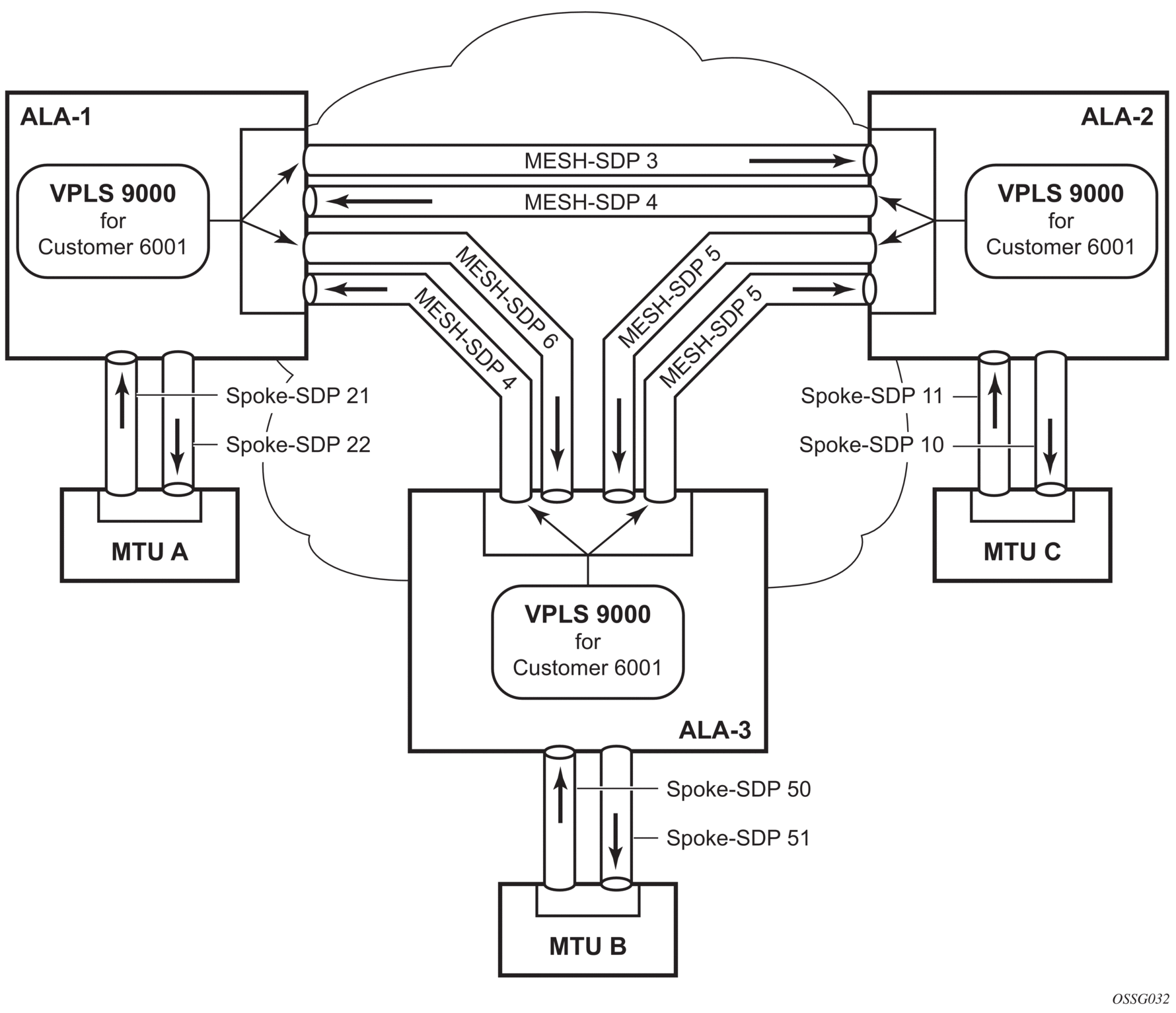
Use the following CLI syntax to create mesh or spoke-SDP bindings with a distributed VPLS service. SDPs must be configured prior to binding. Refer to the 7450 ESS, 7750 SR, 7950 XRS, and VSR Services Overview Guide for information about creating SDPs.
Use the following CLI syntax to configure mesh SDP bindings.
Use the following CLI syntax to configure spoke-SDP bindings.
The following examples show SDP binding configurations for ALA-1, ALA-2, and ALA-3 for VPLS service ID 9000 for customer 6:
3.5.3.8.1. Configuring Spoke-SDP Specific STP Parameters
When a VPLS has STP enabled, each spoke-SDP within the VPLS has STP enabled by default. The operation of STP on each spoke-SDP is governed by:
3.5.3.8.1.1. Spoke-SDP STP Administrative State
The administrative state of STP within a spoke-SDP controls how BPDUs are transmitted and handled when received. The allowable states are:
- Spoke-SDP Admin UpThe default administrative state is up for STP on a spoke-SDP. BPDUs are handled in the normal STP manner on a spoke-SDP that is administratively up.
- Spoke-SDP Admin DownAn administratively down state allows a service provider to prevent a spoke-SDP from becoming operationally blocked. BPDUs will not originate out the spoke-SDP toward the customer.If STP is enabled on VPLS level, but disabled on the spoke-SDP, received BPDUs are discarded. Discarding the incoming BPDUs allows STP to continue to operate normally within the VPLS service while ignoring the down spoke-SDP. The specified spoke-SDP will always be in an operationally forwarding state.

Note: The administratively down state allows a loop to form within the VPLS.
Range: shutdown or no shutdown
Default: no shutdown (spoke-SDP admin up)
3.5.3.8.1.2. Spoke-SDP Virtual Port Number
The virtual port number uniquely identifies a spoke-SDP within configuration BPDUs. The internal representation of a spoke-SDP is unique to a system and has a reference space much bigger than the 12 bits definable in a configuration BPDU. STP takes the internal representation value of a spoke-SDP and identifies it with its own virtual port number that is unique to every other spoke-SDP defined on the VPLS. The virtual port number is assigned at the time that the spoke-SDP is added to the VPLS.
Since the order in which spoke-SDPs are added to the VPLS is not preserved between reboots of the system, the virtual port number may change between restarts of the STP instance. To achieve consistency after a reboot, the virtual port number can be specified explicitly.
Range: 1 to 2047
Default: automatically generated
Restore Default: no port-num
3.5.3.8.1.3. Spoke-SDP Priority
Spoke-SDP priority allows a configurable tiebreaking parameter to be associated with a spoke-SDP. When configuration BPDUs are being received, the configured spoke-SDP priority will be used in some circumstances to determine whether a spoke-SDP will be designated or blocked.
In traditional STP implementations (802.1D-1998), this field is called the port priority and has a value of 0 to 255. This field is coupled with the port number (0 to 255 also) to create a 16-bit value. In the latest STP standard (802.1D-2004), only the upper 4 bits of the port priority field are used to encode the spoke-SDP priority. The remaining 4 bits are used to extend the port ID field into a 12-bit virtual port number field. The virtual port number uniquely references a spoke-SDP within the STP instance. See Spoke-SDP Virtual Port Number for more information about the virtual port number.
STP computes the actual spoke-SDP priority by taking the configured priority value and masking out the lower four bits. The result is the value that is stored in the spoke-SDP priority parameter. For instance, if a value of 0 was entered, masking out the lower 4 bits would result in a parameter value of 0. If a value of 255 was entered, the result would be 240.
The default value for spoke-SDP priority is 128. This parameter can be modified within a range of 0 to 255; 0 being the highest priority. Masking causes the values actually stored and displayed to be 0 to 240, in increments of 16.
Range: 0 to 255 (240 largest value, in increments of 16)
Default: 128
Restore Default: no priority
3.5.3.8.1.4. Spoke-SDP Path Cost
The spoke-SDP path cost is used by STP to calculate the path cost to the root bridge. The path cost in BPDUs received on the root port is incremented with the configured path cost for that spoke-SDP. When BPDUs are sent out of other egress spoke-SDPs, the newly calculated root path cost is used.
STP suggests that the path cost is defined as a function of the link bandwidth. Since spoke-SDPs are controlled by complex queuing dynamics, the STP path cost is a purely static configuration.
The default value for spoke-SDP path cost is 10. This parameter can be modified within a range of 1 to 200000000 (1 is the lowest cost).
Range: 1 to 200000000
Default: 10
Restore Default: no path-cost
3.5.3.8.1.5. Spoke-SDP Edge Port
The spoke-SDP edge-port command is used to reduce the time it takes a spoke-SDP to reach the forwarding state when the spoke-SDP is on the edge of the network, and therefore has no further STP bridge to handshake with.
The edge-port command is used to initialize the internal OPER_EDGE variable. At any time, when OPER_EDGE is false on a spoke-SDP, the normal mechanisms are used to transition to the forwarding state (see Forward Delay). When OPER_EDGE is true, STP assumes that the remote end agrees to transition to the forwarding state without actually receiving a BPDU with an agreement flag set.
The OPER_EDGE variable will dynamically be set to false if the spoke-SDP receives BPDUs (the configured edge-port value does not change). The OPER_EDGE variable will dynamically be set to true if auto-edge is enabled and STP concludes there is no bridge behind the spoke-SDP.
When STP on the spoke-SDP is administratively disabled and re-enabled, the OPER_EDGE is re-initialized to the spoke-SDP configured for edge-port.
Valid values for spoke-SDP edge-port are enabled and disabled, with disabled being the default.
Default: no edge-port
3.5.3.8.1.6. Spoke-SDP Auto Edge
The spoke-SDP edge-port command is used to instruct STP to dynamically decide whether the spoke-SDP is connected to another bridge.
If auto-edge is enabled, and STP concludes there is no bridge behind the spoke-SDP, the OPER_EDGE variable will dynamically be set to true. If auto-edge is enabled, and a BPDU is received, the OPER_EDGE variable will dynamically be set to true (see Spoke-SDP Edge Port).
Valid values for spoke-SDP auto-edge are enabled and disabled, with enabled being the default.
Default: auto-edge
3.5.3.8.1.7. Spoke-SDP Link Type
The spoke-SDP link-type command instructs STP on the maximum number of bridges behind this spoke-SDP. If there is only a single bridge, transitioning to forwarding state will be based on handshaking (fast transitions). If more than two bridges are connected by a shared media, their spoke-SDPs should all be configured as shared, and timer-based transitions are used.
Valid values for spoke-SDP link-type are shared and pt-pt, with pt-pt being the default.
Default: link-type pt-pt
Restore Default: no link-type
3.5.3.8.2. Spoke-SDP STP Operational States
The operational state of STP within a spoke-SDP controls how BPDUs are transmitted and handled when received. Defined states are:
3.5.3.8.2.1. Operationally Disabled
Operationally disabled is the normal operational state for STP on a spoke-SDP in a VPLS that has any of the following conditions:
- VPLS state administratively down
- Spoke-SDP state administratively down
- Spoke-SDP state operationally down
If the spoke-SDP enters the operationally up state with the STP administratively up and the spoke-SDP STP state is up, the spoke-SDP will transition to the STP spoke-SDP discarding state.
When, during normal operation, the router detects a downstream loop behind a spoke-SDP, BPDUs can be received at a very high rate. To recover from this situation, STP will transition the spoke-SDP to a disabled state for the configured forward-delay duration.
3.5.3.8.2.2. Operationally Discarding
A spoke-SDP in the discarding state only receives and sends BPDUs, building the local correct STP state for each spoke-SDP while not forwarding actual user traffic. The duration of the discarding state is explained in section Forward Delay.
| Note: In previous versions of the STP standard, the discarding state was called a blocked state. |
3.5.3.8.2.3. Operationally Learning
The learning state allows population of the MAC forwarding table before entering the forwarding state. In this state, no user traffic is forwarded.
3.5.3.8.2.4. Operationally Forwarding
Configuration BPDUs are sent out of a spoke-SDP in the forwarding state. Layer 2 frames received on the spoke-SDP are source learned and destination forwarded according to the FDB. Layer 2 frames received on other forwarding interfaces and destined for the spoke-SDP are also forwarded.
3.5.3.8.2.5. Spoke-SDP BPDU Encapsulation States
IEEE 802.1D (referred as dot1d) and Cisco’s per VLAN Spanning Tree (PVST) BPDU encapsulations are supported on a per spoke-SDP basis. STP is associated with a VPLS service like PVST is per VLAN. The main difference resides in the Ethernet and LLC framing and a type-length-value (TLV) field trailing the BPDU.
Table 18 shows differences between dot1D and PVST Ethernet BPDU encapsulations based on the interface encap-type field.
Table 18: Spoke-SDP BPDU Encapsulation States
Field | dot1d encap-type null | dot1d encap-type dot1q | PVST encap-type null | PVST encap-type dot1q |
Destination MAC | 01:80:c2:00:00:00 | 01:80:c2:00:00:00 | N/A | 01:00:0c:cc:cc:cd |
Source MAC | Sending Port MAC | Sending Port MAC | N/A | Sending Port MAC |
EtherType | N/A | 0x81 00 | N/A | 0x81 00 |
Dot1p and DEI | N/A | 0xe | N/A | 0xe |
Dot1q | N/A | VPLS spoke-SDP ID | N/A | VPLS spoke-SDP encap value |
Length | LLC Length | LLC Length | N/A | LLC Length |
LLC DSAP SSAP | 0x4242 | 0x4242 | N/A | 0xaaaa (SNAP) |
LLC CNTL | 0x03 | 0x03 | N/A | 0x03 |
SNAP OUI | N/A | N/A | N/A | 00 00 0c (Cisco OUI) |
SNAP PID | N/A | N/A | N/A | 01 0b |
CONFIG or TCN BPDU | Standard 802.1d | Standard 802.1d | N/A | Standard 802.1d |
TLV: Type and Len | N/A | N/A | N/A | 58 00 00 00 02 |
TLV: VLAN | N/A | N/A | N/A | VPLS spoke-SDP encap value |
Padding | As Required | As Required | N/A | As Required |
Each spoke-SDP has a Read Only operational state that shows which BPDU encapsulation is currently active on the spoke-SDP. The following states apply:
- Dot1d specifies that the switch is currently sending IEEE 802.1D standard BPDUs. The BPDUs will be tagged or non-tagged based on the encapsulation type of the egress interface and the encapsulation value defined in the spoke-SDP. A spoke-SDP defined on an interface with encapsulation type dot1q will continue in the dot1d BPDU encapsulation state until a PVST encapsulated BPDU is received, after which the spoke-SDP will convert to the PVST encapsulation state. Each received BPDU must be properly IEEE 802.1q tagged if the interface encapsulation type is defined asdot1q.
- PVST specifies that the switch is currently sending proprietary encapsulated BPDUs. PVST BPDUs are only supported on Ethernet interfaces with the encapsulation type set to dot1q. The spoke-SDP continues in the PVST BPDU encapsulation state until a dot1d encapsulated BPDU is received, in which case the spoke-SDP reverts to the dot1d encapsulation state. Each received BPDU must be properly IEEE 802.1q tagged with the encapsulation value defined for the spoke-SDP.
Dot1d is the initial and only spoke-SDP BPDU encapsulation state for spoke-SDPs defined on an Ethernet interface with encapsulation type set to null.
Each transition between encapsulation types optionally generates an alarm that can be logged and optionally transmitted as an SNMP trap.
3.5.3.8.3. Configuring VPLS Spoke-SDPs with Split Horizon
To configure spoke-SDPs with a split horizon group, add the split-horizon-group parameter when creating the spoke-SDP. Traffic arriving on a SAP or spoke-SDP within a split horizon group will not be copied to other SAPs or spoke-SDPs in the same split horizon group.
The following example shows a VPLS configuration with split horizon enabled:
3.5.4. Configuring VPLS Redundancy
This section discusses VPLS redundancy service management tasks.
3.5.4.1. Creating a Management VPLS for SAP Protection
This section provides a brief overview of the tasks that must be performed to configure a management VPLS for SAP protection and provides the CLI commands; see Figure 95. The following tasks should be performed on both nodes providing the protected VPLS service.
Before configuring a management VPLS, see VPLS Redundancy for an introduction to the concept of management VPLS and SAP redundancy.
- Create an SDP to the peer node.
- Create a management VPLS.
- Define a SAP in the M-VPLS on the port toward the MTU. The port must be dot1q or qinq tagged. The SAP corresponds to the (stacked) VLAN on the MTU in which STP is active.
- Optionally, modify STP parameters for load balancing.
- Create a mesh SDP in the M-VPLS using the SDP defined in Step 1. Ensure that this mesh SDP runs over a protected LSP (see the following note).
- Enable the management VPLS service and verify that it is operationally up.
- Create a list of VLANs on the port that are to be managed by this management VPLS.
- Create one or more user VPLS services with SAPs on VLANs in the range defined by Step 6.

Note: The mesh SDP should be protected by a backup LSP or Fast Reroute. If the mesh SDP went down, STP on both nodes would go to forwarding state and a loop would occur.
Figure 95: Example Configuration for Protected VPLS SAP
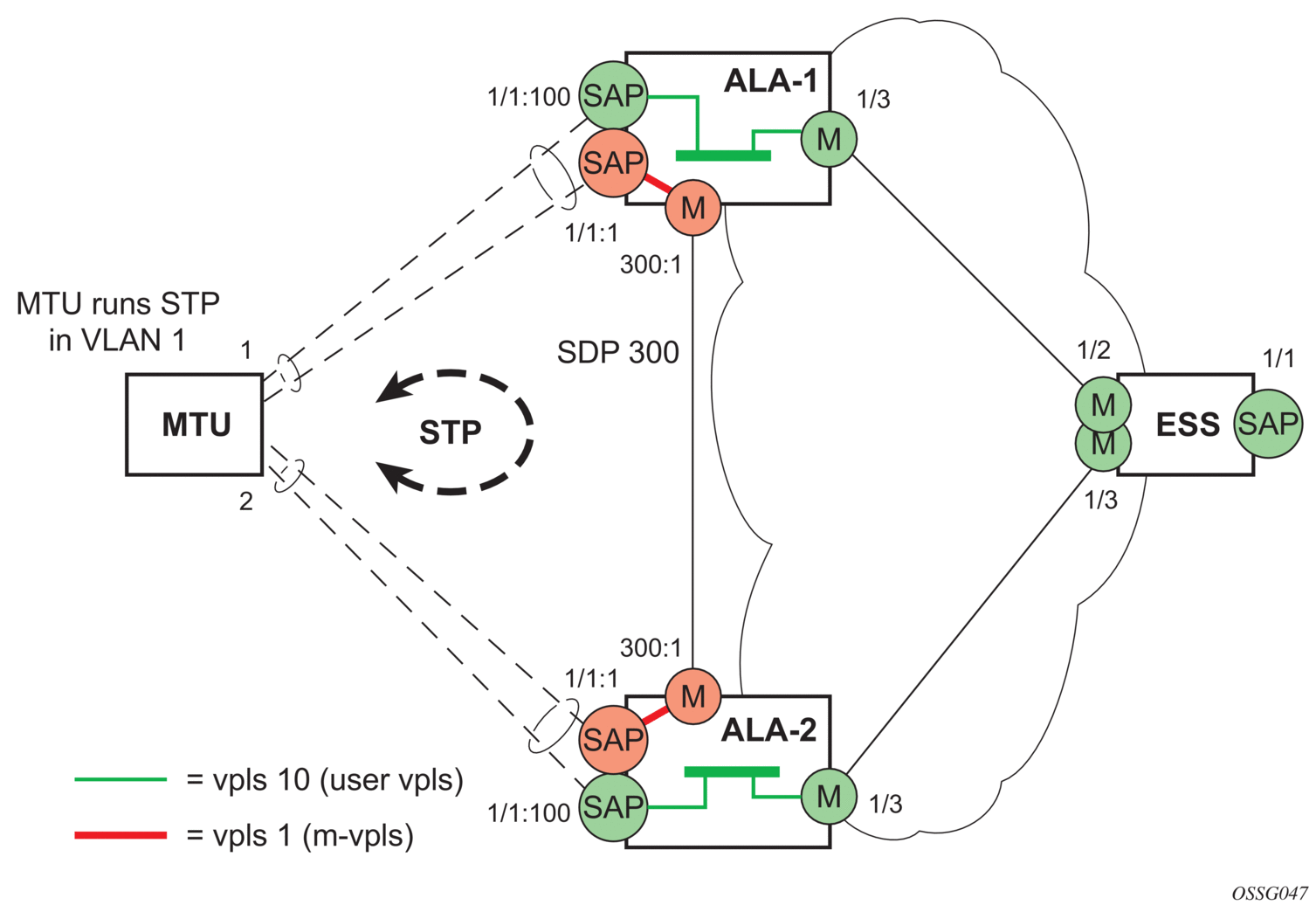
Use the following CLI syntax to create a management VPLS on the 7450 ESS or 7750 SR.
The following example shows a VPLS configuration:
3.5.4.2. Creating a Management VPLS for Spoke-SDP Protection
This section provides a brief overview of the tasks that must be performed to configure a management VPLS for spoke-SDP protection and provides the CLI commands; see Figure 96. The following tasks should be performed on all four nodes providing the protected VPLS service. Before configuring a management VPLS, see Configuring a VPLS SAP for an introduction to the concept of management VPLS and spoke-SDP redundancy.
- Create an SDP to the local peer node (node ALA-A2 in the following example).
- Create an SDP to the remote peer node (node ALA-B1 in the following example).
- Create a management VPLS.
- Create a spoke-SDP in the M-VPLS using the SDP defined in Step 1. Ensure that this mesh SDP runs over a protected LSP (see note below).
- Enable the management VPLS service and verify that it is operationally up.
- Create a spoke-SDP in the M-VPLS using the SDP defined in Step 2. Optionally, modify STP parameters for load balancing (see Configuring Load Balancing with Management VPLS).
- Create one or more user VPLS services with spoke-SDPs on the tunnel SDP defined by Step 2.
As long as the user spoke-SDPs created in step 7 are in this same tunnel SDP with the management spoke-SDP created in step 6, the management VPLS will protect them.
| Note: The SDP should be protected by, for example, a backup LSP or Fast Reroute. If the SDP went down, STP on both nodes would go to forwarding state and a loop would occur. |
Figure 96: Example Configuration for Protected VPLS Spoke-SDP
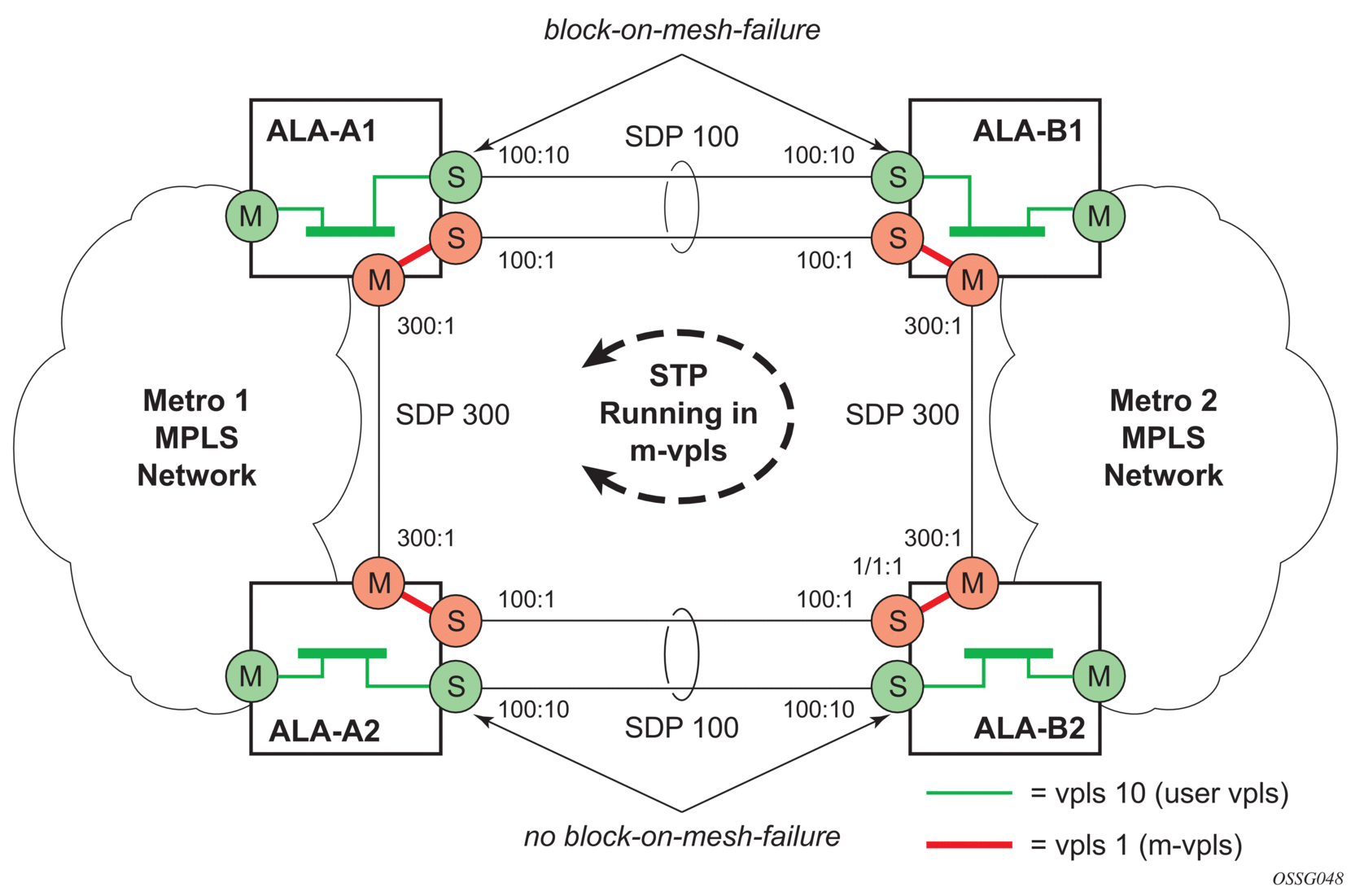
Use the following CLI syntax to create a management VPLS for spoke-SDP protection.
The following example shows a VPLS configuration:
3.5.4.3. Configuring Load Balancing with Management VPLS
With the concept of management VPLS, it is possible to load balance the user VPLS services across the two protecting nodes. This is done by creating two management VPLS instances, where both instances have different active QinQ spokes (by changing the STP path-cost). When user VPLS services are associated with either of the two management VPLS services, the traffic will be split across the two QinQ spokes. Load balancing can be achieved in both the SAP protection and spoke-SDP protection scenarios.
Figure 97 shows an example configuration for load balancing across two protected VPLS spoke-SDPs.
Figure 97: Example Configuration for Load Balancing Across Two Protected VPLS Spoke-SDPs
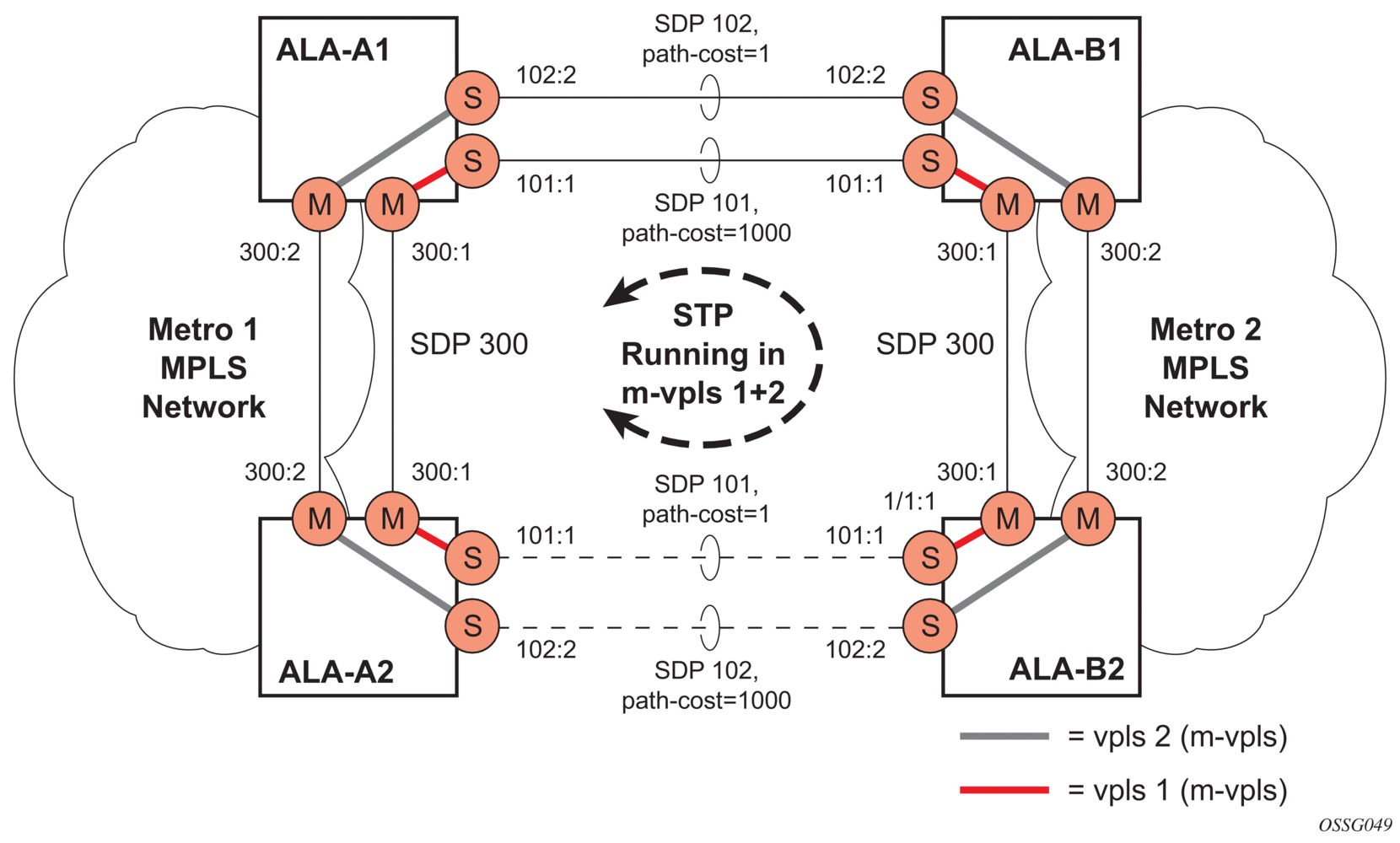
Use the following CLI syntax to create load balancing across two management VPLS instances.
| Note: The STP path costs in each peer node should be reversed. |
The following example shows the VPLS configuration on ALA-A1 (top left, IP address 10.0.0.10):
The following example shows the VPLS configuration on ALA-A2 (bottom left, IP address 10.0.0.20):
The following example shows the VPLS configuration on ALA-A3 (top right, IP address 10.0.0.30):
The following example shows the VPLS configuration on ALA-A4 (bottom right, IP address 10.0.0.40):
3.5.4.4. Configuring Selective MAC Flush
Use the following CLI syntax to enable selective MAC flush in a VPLS.
Use the following CLI syntax to disable selective MAC flush in a VPLS.
3.5.4.5. Configuring Multi-Chassis Endpoints
The following output shows configuration examples of multi-chassis redundancy and the VPLS configuration. The configurations in the graphics depicted in Inter-Domain VPLS Resiliency Using Multi-Chassis Endpoints are represented in this output.
Node mapping to the following examples in this section:
- PE3 = Dut-B
- PE3' = Dut-C
- PE1 = Dut-D
- PE2 = Dut-E
PE3 Dut-B
PE3' Dut-C
PE1 Dut-D
PE2 Dut-E
3.5.5. ATM/Frame Relay PVC Access and Termination on a VPLS Service
The application as shown in Figure 98 provides access to a VPLS service to Frame Relay and ATM users connected either directly or through an ATM access network to a 7750 SR PE node. The 7750 SR supports a Frame Relay or an ATM VC-delimited Service Access Point (SAP) terminating on a VPLS service.
Figure 98: ATM/Frame Relay PVC Access and Termination on a VPLS Example
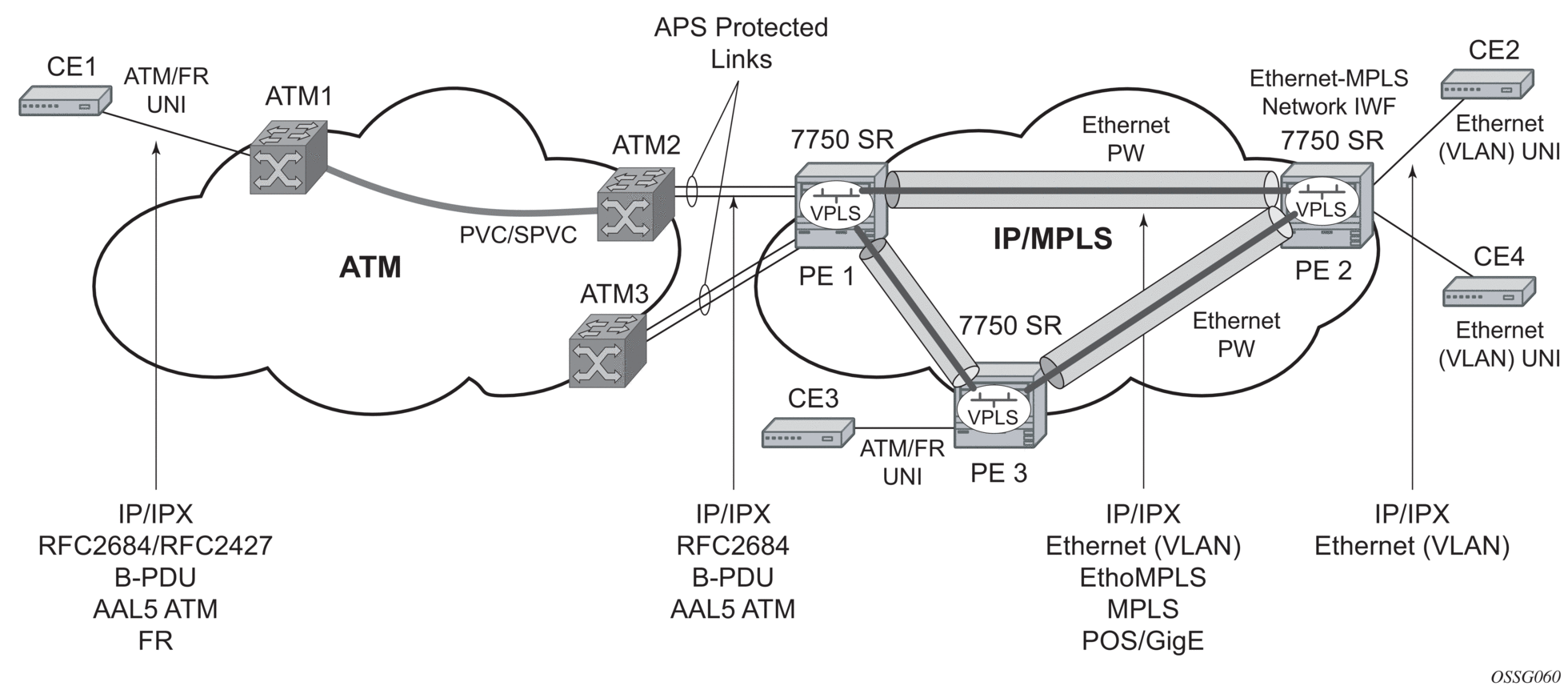
RFC 2427-encapsulated or RFC 2684-encapsulated untagged Ethernet/802.3 frames (with or without Frame Check Sequence (FCS)) or BPDUs from a customer’s bridge device are received on a specified SAP over an ATM or Frame Relay interface on the 7750 SR. The Frame Relay or ATM-related encapsulation is stripped and the frames (without FCS) are forwarded toward destination SAPs either locally, or using SDPs associated with the VPLS service (as required by destination MAC address VPLS processing). In the egress direction, the received untagged frames are encapsulated into RFC 2427 or RFC 2684 (no Q-tags are added, no FCS in the forwarded frame) and sent over ATM or a FR VC toward the customer CPE.
When AAL5 RFC 2427/2684-encapsulated tagged frames are received from the customer’s bridge on an FR/ATM SAP, the tags are transparent and the frames are processed as described above with the exception that the frames forwarded toward the destination(s) will have the received tags preserved. Similarly in the egress direction, the received tagged Ethernet frames are encapsulated as is (that is, Q-tags are again transparent and preserved) into RFC 2427/2684 and sent over the FR/ATM PVC toward the customer CPE. Since the tagging is transparent, the 7750 SR performs unqualified MAC learning (for example, MAC addresses are learned without reference to VLANs they are associated with). Because of that, MAC addresses used must be unique across all the VLANs used by the customer for a specified VPLS service instance. If a customer wants a per-VLAN separation, the VLAN traffic that needs to be separated must come on different VCs (different SAPs) associated with different VPLS service instances.
All VPLS functionality available on the 7750 SR is applicable to FR and ATM-delimited VPLS SAPs. For example, bridged PDUs received over ATM SAP can be tunneled through or dropped, all FIB functionality applies, packet level QoS and MAC filtering applies, and so on. Also, split horizon groups are applicable to ATM SAPs terminating on VPLS. That is, frame forwarding between ATM SAPs, also referred to as VCI-to-VCI forwarding, within the same group is disabled.
The Ethernet pseudowire is established using Targeted LDP (TLDP) signaling and uses the ether, vlan, or vpls VC type on the SDP. The SDP can be an MPLS or a GRE type.
3.5.6. Configuring BGP Auto-Discovery
This section provides important information to explain the different configuration options used to populate the required BGP AD and generate the LDP generalized pseudowire-ID FEC fields. There are a large number of configuration options that are available with this feature. Not all these configuration options are required to start using BGP AD. At the end of this section, it will be apparent that a simple configuration will automatically generate the required values used by BGP and LDP. In most cases, deployments will provide full mesh connectivity between all nodes across a VPLS instance. However, capabilities are available to influence the topology and build hierarchies or hub and spoke models.
3.5.6.1. Configuration Steps
Using Figure 99, assume PE6 was previously configured with VPLS 100 as indicated by the configurations code in the upper right. The BGP AD process will commence after PE134 is configured with the VPLS 100 instance, as shown in the upper left. This shows a basic BGP AD configuration. The minimum requirement for enabling BGP AD on a VPLS instance is configuring the VPLS-ID and pointing to a pseudowire template.
Figure 99: BGP AD Configuration Example
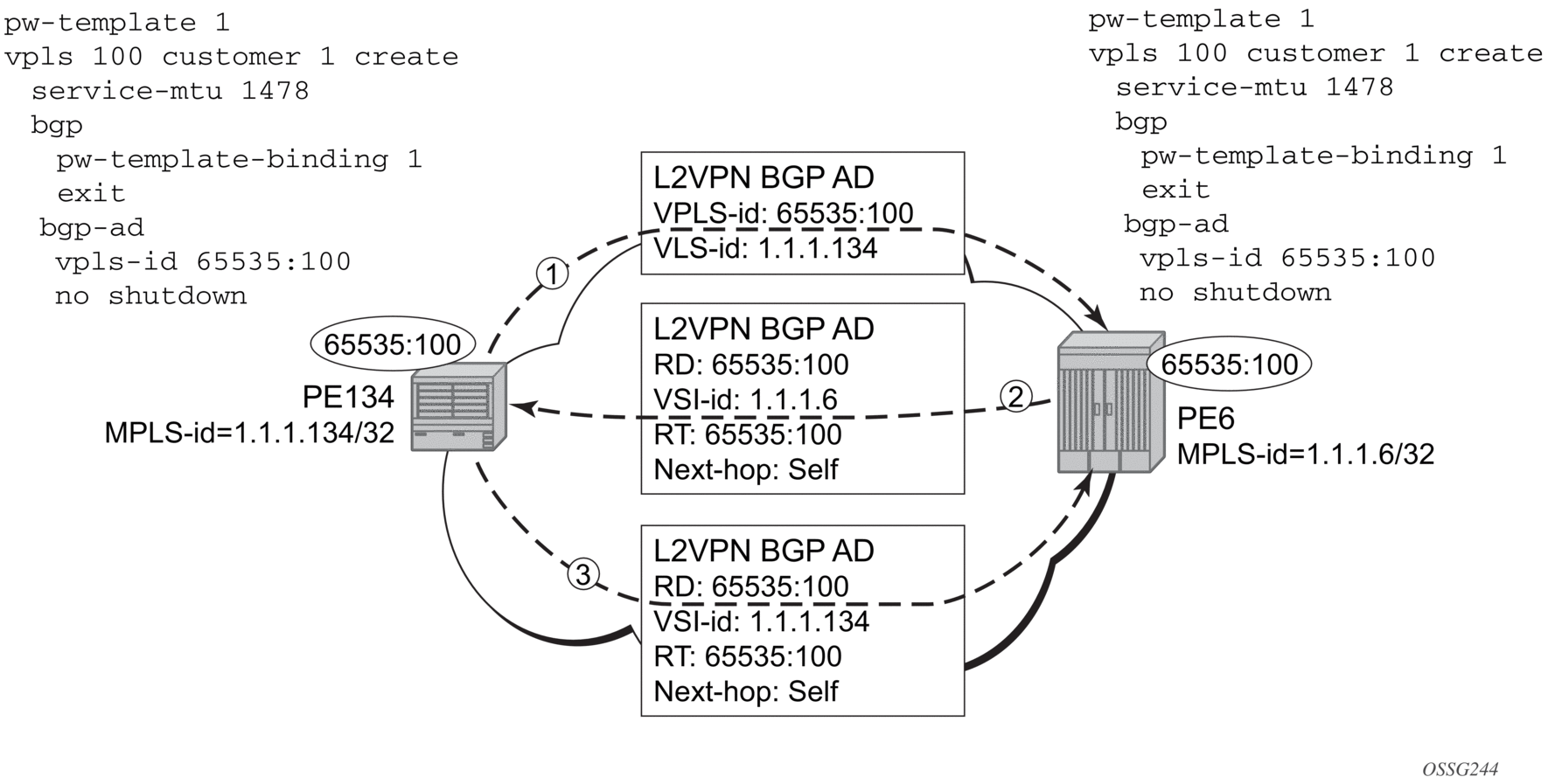
In many cases, VPLS connectivity is based on a pseudowire mesh. To reduce the configuration requirement, the BGP values can be automatically generated using the VPLS-ID and the MPLS router-ID. By default, the lower six bytes of the VPLS-ID are used to generate the RD and the RT values. The VSI-ID value is generated from the MPLS router-ID. All of these parameters are configurable and can be coded to suit requirements and build different topologies.
The show service command shows the service information, the BGP parameters, and the SDP bindings in use. When the discovery process is completed successfully, each endpoint will have an entry for the service.
When only one of the endpoints has an entry for the service in the l2-routing-table, it is most likely a problem with the RT values used for import and export. This would most likely happen when different import and export RT values are configured using a router policy or the route-target command.
Service-specific commands continue to be available to show service-specific information, including status:
BGP AD will advertise the VPLS-ID in the extended community attribute, VSI-ID in the NLRI, and the local PE ID in the BGP next hop. At the receiving PE, the VPLS-ID is compared against locally provisioned information to determine whether the two PEs share a common VPLS. If they do, the BGP information is used in the signaling phase (see Configuring BGP VPLS).
3.5.6.2. LDP Signaling
T-LDP is triggered when the VPN endpoints have been discovered using BGP. The T-LDP session between the PEs is established when a session does not exist. The far-end IP address required for the T-LDP identification is learned from the BGP AD next hop information. The pw-template and pw-template-binding configuration statements are used to establish the automatic SDP or to map to the appropriate SDP. The FEC129 content is built using the following values:
- AGI from the locally configured VPLS-ID
- SAII from the locally configured VSI-ID
- TAII from the VSI-ID contained in the last 4 bytes of the received BGP NLRI
Figure 100 shows the different detailed phases of the LDP signaling path, post BGP AD completion. It also indicates how some fields can be auto-generated when they are not specified in the configuration.
Figure 100: BGP AD Triggering LDP Functions
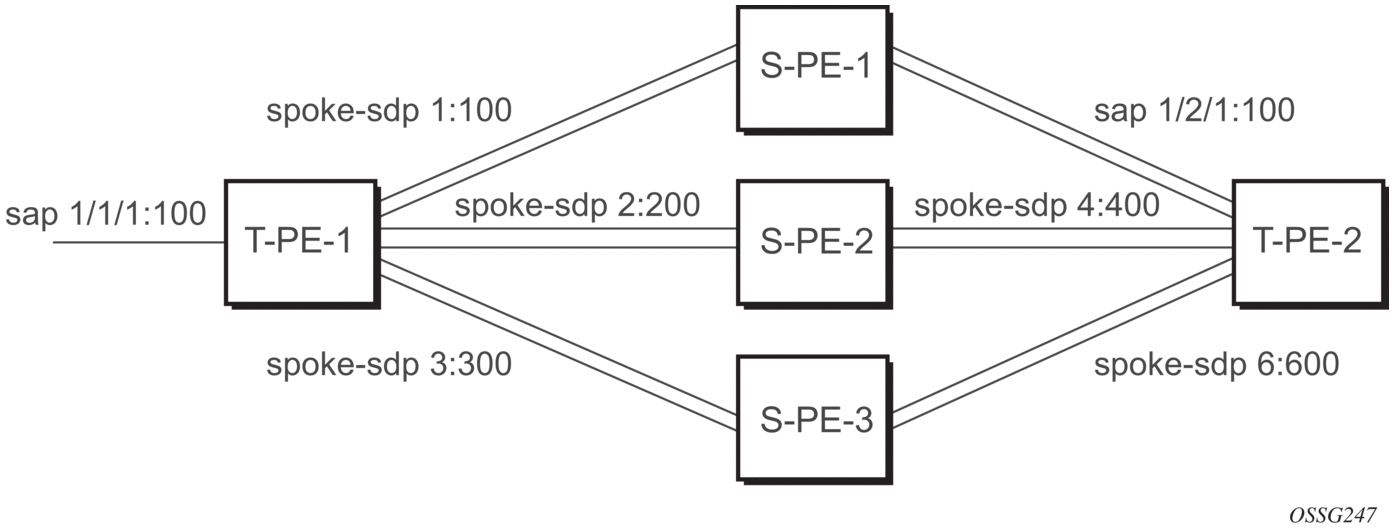
The following command shows the LDP peering relationships that have been established (see Figure 101). The type of adjacency is displayed in the “Adj Type” column. In this case, the type is “Both” meaning link and targeted sessions have been successfully established.
Figure 101: Show Router LDP Session Output

The following command shows the specific LDP service label information broken up per FEC element type: 128 or 129, basis (see Figure 102). The information for FEC element 129 includes the AGI, SAII, and the TAII.
Figure 102: Show Router LDP Bindings FEC-Type Services
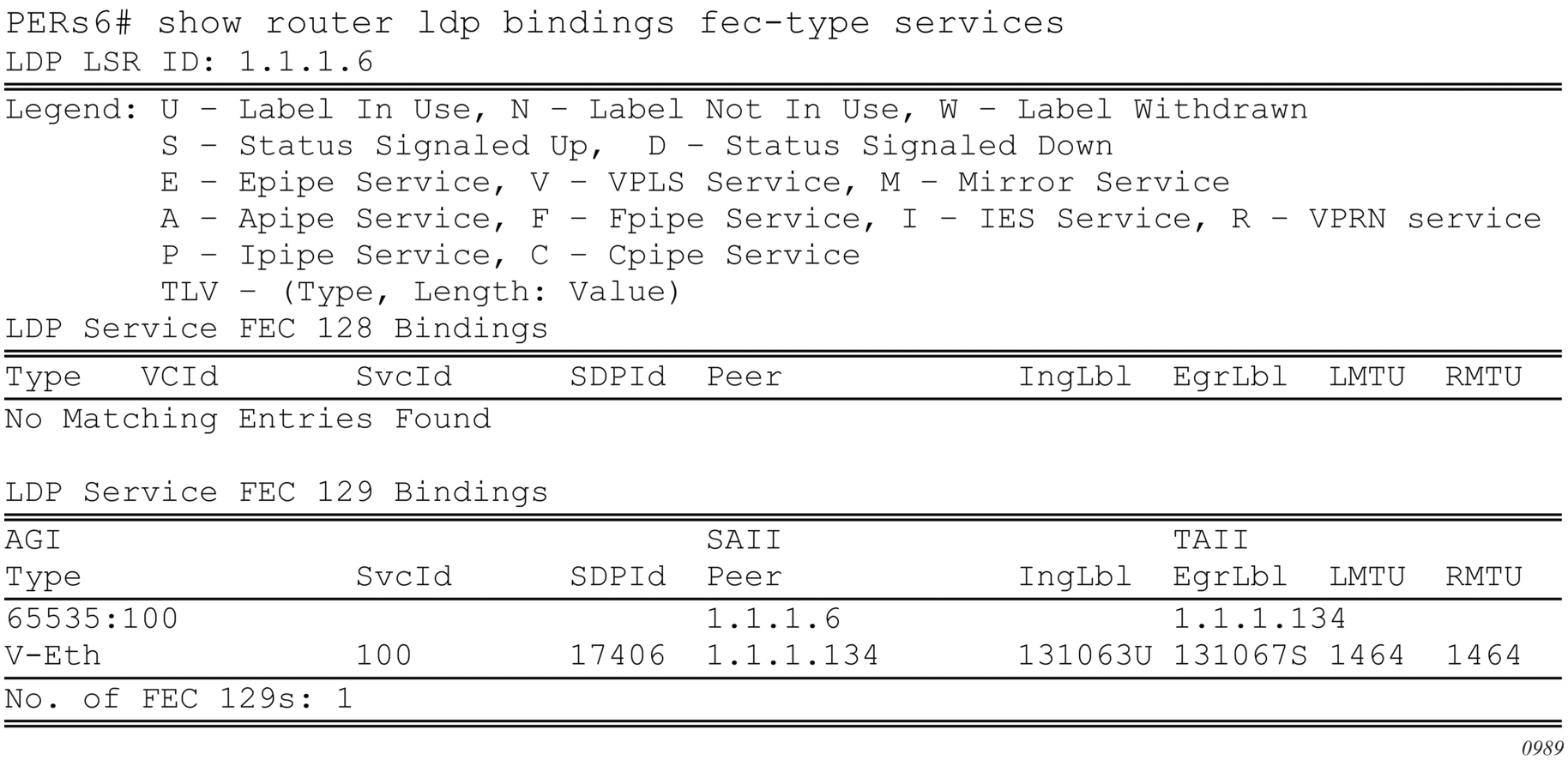
3.5.6.3. Pseudowire Template
The pseudowire template is defined under the top-level service command (config>service>pw-template) and specifies whether to use an automatically generated SDP or manually configured SDP. It also provides the set of parameters required for establishing the pseudowire (SDP binding) as follows:
A pw-template-binding command configured within the VPLS service under the bgp-ad sub-command is a pointer to the pw-template that should be used. If a VPLS service does not specify an import-rt list, then that binding applies to all route targets accepted by that VPLS. The pw-template-bind command can select a different template on a per import-rt basis. It is also possible to specify specific pw-templates for some route targets with a VPLS service and use the single pw-template-binding command to address all unspecified but accepted imported targets.
Figure 103: PW-Template-Binding CLI Syntax
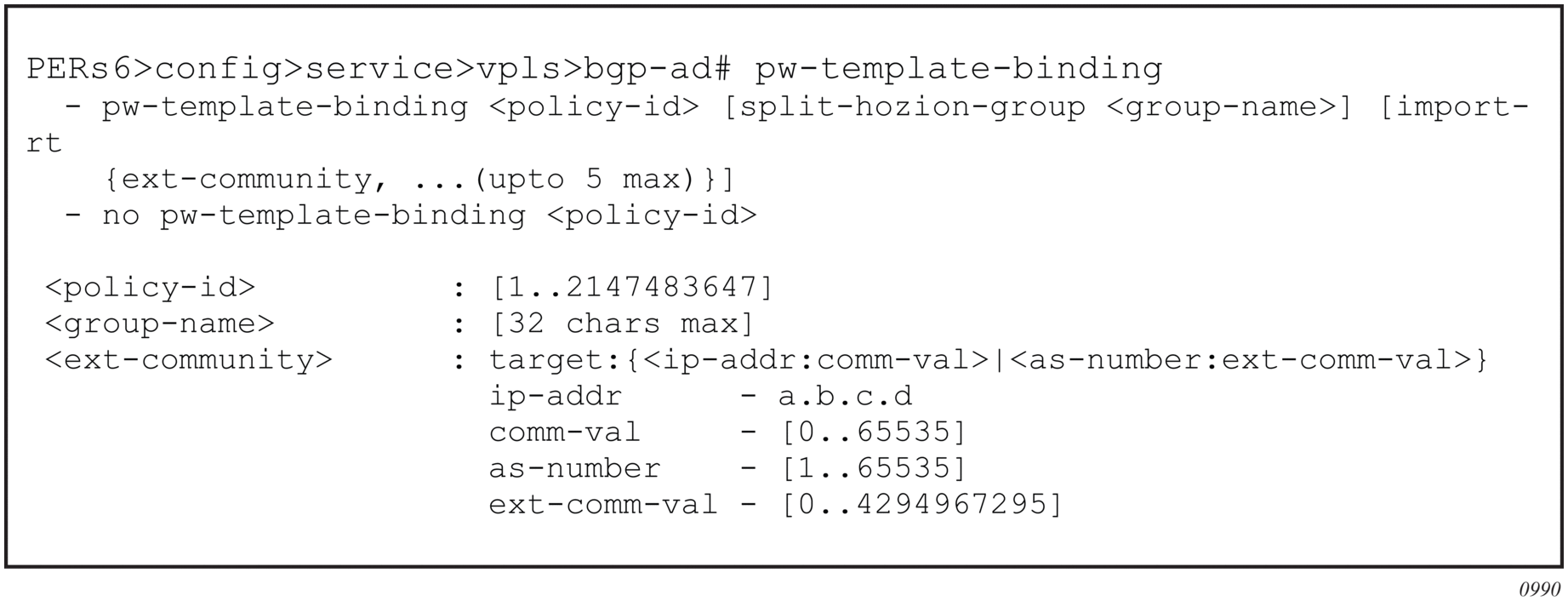
It is important to understand the significance of the split horizon group used by the pw-template. Traditionally, when a VPLS instance was manually created using mesh-SDP bindings, these were automatically placed in a common split horizon group to prevent forwarding between the pseudowire in the VPLS instances. This prevents loops that would have otherwise occurred in the Layer 2 service. When automatically discovering VPLS service using BGP AD, the service provider has the option of associating the auto-discovered pseudowire with a split horizon group to control the forwarding between pseudowires.
3.5.7. Configuring BGP VPLS
This section provides a configuration example required to bring up BGP VPLS in the VPLS PEs depicted in Figure 104.
Figure 104: BGP VPLS Example
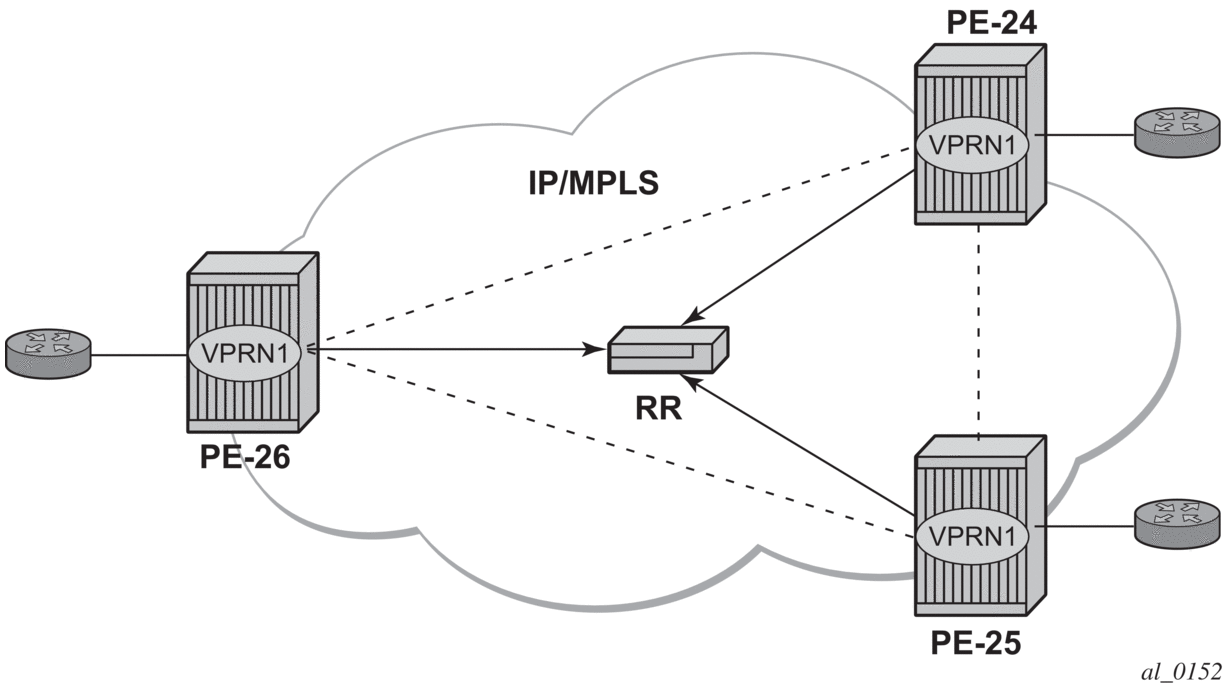
The red BGP VPLS is configured in the PE24, PE25, and PE26 using the commands shown in the following CLI examples:
3.5.7.1. Configuring a VPLS Management Interface
Use the following CLI syntax to create a VPLS management interface:
The following example shows the configuration.
3.5.8. Configuring Policy-Based Forwarding for Deep Packet Inspection (DPI) in VPLS
The purpose of policy-based forwarding is to capture traffic from a customer and perform a deep packet inspection (DPI) and forward traffic, if allowed, by the DPI on the 7450 ESS or 7750 SR.
In the following example, the split horizon groups are used to prevent flooding of traffic. Traffic from customers enter at SAP 1/1/5:5. Due to the mac-filter 100 that is applied on ingress, all traffic with dot1p 07 marking will be forwarded to SAP 1/1/22:1, which is the DPI.
DPI performs packet inspection/modification and either drops the traffic or forwards the traffic back into the box through SAP 1/1/21:1. Traffic will then be sent to spoke-SDP 3:5.
SAP 1/1/23:5 is configured to determine whether the VPLS service is flooding all the traffic. If flooding is performed by the router, traffic would also be sent to SAP 1/1/23:5 (which it should not).
Figure 105 shows an example to configure policy-based forwarding for deep packet inspection on a VPLS service. For information about configuring filter policies, refer to the 7450 ESS, 7750 SR, 7950 XRS, and VSR Router Configuration Guide.
Figure 105: Policy-Based Forwarding For Deep Packet Inspection

The following example shows the service configuration:
The following example shows the MAC filter configuration:
The following example shows the service configuration with a MAC filter:
3.5.9. Configuring VPLS E-Tree Services
When configuring a VPLS E-Tree service, the etree keyword must be specified when the VPLS service is created. This is the first operation required before any SAPs or SDPs are added to the service, since the E-Tree service type affects the operations of the SAPs and SDP bindings.
When configuring AC SAPs, the configuration model is very similar to normal SAPs. Since the VPLS service must be designated as an E-Tree, the default AC SAP is a root-ac SAP. An E-Tree service with all root-ac behaves just as a regular VPLS service. A leaf-ac SAP must be configured for leaf behavior.
For root-leaf-tag SAPs, the SAP is created with both root and leaf VIDs. The 1/1/1:x.* or 1/1/1:x would be the typical format, where x designates the root tag. A leaf-tag is configured at SAP creation and replaces the x with a leaf-tag VID. Combined statistics for root and leaf SAPs are reported under the SAP. There are no individual statistics shown for root and leaf.
The following example illustrates the configuration of a VPLS E-Tree service with root-ac (default configuration for SAPs and SDP binds) and leaf-ac interfaces, as well as a root leaf tag SAP and SDP bind.
In the example, the SAP 1/1/7:2006.200 is configured using the root-leaf-tag parameter, where the outer VID 2006 is used for root traffic and the outer VID 2007 is used for leaf traffic.
3.6. Service Management Tasks
This section describes VPLS service management tasks.
3.6.1. Modifying VPLS Service Parameters
You can change existing service parameters. The changes are applied immediately. To display a list of services, use the show service service-using vpls command. Enter the parameter such as description, SAP, SDP, and/or service-MTU command syntax, then enter the new information.
The following shows a modified VPLS configuration:
3.6.2. Modifying Management VPLS Parameters
To modify the range of VLANs on an access port that are to be managed by an existing management VPLS, the new range should be defined, then the old range removed. If the old range is removed before a new range is defined, all customer VPLS services in the old range will become unprotected and may be disabled.
3.6.3. Deleting a Management VPLS
As with normal VPLS service, a management VPLS cannot be deleted until SAPs and SDPs are unbound (deleted), interfaces are shut down, and the service is shut down on the service level.
Use the following CLI syntax to delete a management VPLS service.
3.6.4. Disabling a Management VPLS
You can shut down a management VPLS without deleting the service parameters.
When a management VPLS is disabled, all associated user VPLS services are also disabled (to prevent loops). If this is not needed, un-manage the user’s VPLS service by removing them from the managed-vlan-list or moving the spoke-SDPs to another tunnel SDP.
3.6.5. Deleting a VPLS Service
A VPLS service cannot be deleted until SAPs and SDPs are unbound (deleted), interfaces are shut down, and the service is shut down on the service level.
Use the following CLI syntax to delete a VPLS service.
3.6.6. Disabling a VPLS Service
You can shut down a VPLS service without deleting the service parameters.
3.6.7. Re-enabling a VPLS Service
Use the following CLI syntax to re-enable a VPLS service that was shut down.